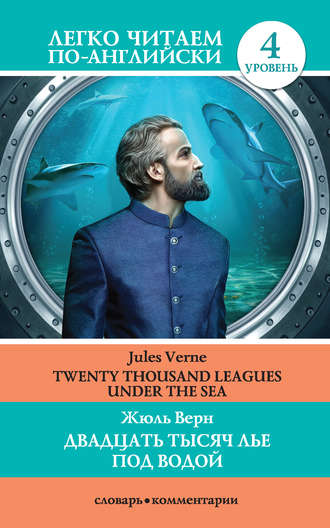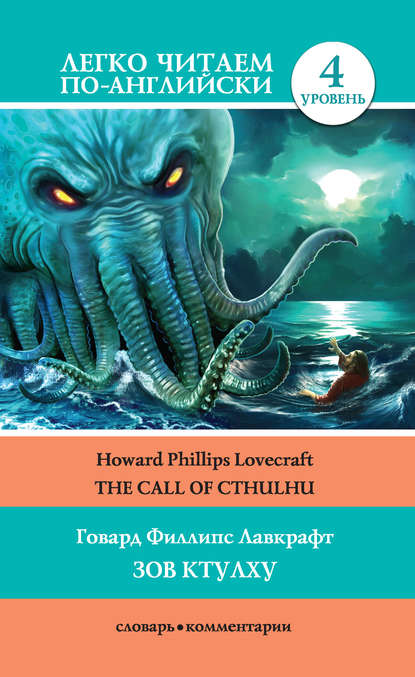
Полная версия
Двадцать тысяч лье под водой / Twenty Thousand Leagues Under the Sea

Жюль Верн / Jules Verne
Двадцать тысяч лье под водой / Twenty Thousand Leagues Under the Sea
© Матвеев С. А., адаптация текста, коммент., и словарь, 2019
© ООО «Издательство АСТ», 2019
Part I
Chapter 1
The year 1866 was marked by a bizarre development, an unexplained phenomenon that surely no one has forgotten. It must be said that professional seamen were especially alarmed. Traders, shipowners, captains of vessels, skippers, and master mariners from Europe and America, naval officers from every country, and the various national governments on these two continents, were all extremely disturbed by the business.
What happened? Several ships had encountered “an enormous thing” at sea, a long spindle-shaped object, sometimes giving off a phosphorescent glow, infinitely bigger and faster than any whale.
The relevant data on this apparition agreed pretty closely as to the structure of the object or creature in question, its unprecedented speed of movement, its startling locomotive power, and its unique vitality. No naturalists would have accepted the existence of such a monster sight unseen—specifically, unseen by their own scientific eyes.
On July 20, 1866, the steamer Governor Higginson[1] encountered this moving mass five miles off the eastern shores of Australia. Captain Baker[2] at first thought he was in the presence of an unknown reef; but two waterspouts shot out of this inexplicable object and sprang hissing into the air some 150 feet. Similar events were likewise observed in the Pacific seas[3], on July 23 of the same year, by the Christopher Columbus[4]. Both ships had observed the object at two places separated by a distance of more than 700 nautical leagues[5].
Fifteen days later and 2,000 leagues farther, the Helvetia[6], running between the United States and Europe, had seen the monster in latitude 42 degrees 15’ north and longitude 60 degrees 35’ west of Greenwich.
One after another, reports arrived that profoundly affected public opinion. In lighthearted countries, people joked about this phenomenon, but such serious, practical countries as England, America, and Germany were deeply concerned. In every big city they sang about the monster in the coffee houses, they ridiculed it in the newspapers, they dramatized it in the theaters. They even reprinted reports fromancient times: the views of Aristotle and Pliny[7] accepting the existence of such monsters, and so on.
During the first months of the year 1867, the question seemed to be buried, when new facts were brought to the public’s attention. But now it was no longer an issue of a scientific problem to be solved, but a quite real and serious danger to be avoided. The question took an entirely new turn. The monster again became an islet, rock, or reef, but a runaway reef, unfixed and elusive.
On March 5, 1867, the Moravia[8] met a rock marked on no charts. This accident happened around five o’clock in the morning. The officers examined the ocean with the most scrupulous care. They saw nothing, and the Moravia continued on course apparently undamaged. What was it? They were unable to say.
Three weeks later the accident had been reenacted under identical conditions. At 4:17 in the afternoon, when the passengers of the Scotia[9] gathered in the main lounge, a collision occurred. At first the passengers were quite frightened, but their Captain hastened to reassure them. There was no immediate danger.
Later the engineers proceeded to inspect the ship, which had been put in dry dock. They couldn’t believe their eyes. Two and a half meters below its waterline, there gaped a symmetrical gash in the shape of an isosceles triangle! This breach in the sheet iron was perfectly formed. It was truly inexplicable.
From this moment on, any maritime casualty without an established cause was charged to the monster’s account. Thanks to the “monster”, travel between the various continents had become more and more dangerous, and the public spoke up and demanded straight out that the seas were to be purged of this fearsome creature at all costs.
Chapter 2
During the period in which these developments were occurring, I had returned from a scientific expedition. Being an Assistant Professor at the Paris Museum of Natural History, I had been attached to this expedition by the French government. After spending six months in Nebraska, I arrived in New York laden with valuable collections near the end of March. My departure for France was set for early May. In the meantime, I was busy classifying my mineralogical, botanical, and zoological treasures. That’s when that incident took place.
I was perfectly abreast of this question, which was the big news of the day. I had read and reread every American and European newspaper. This mystery puzzled me. Finding it impossible to form any views, I drifted from one extreme to the other.
Only two possible solutions to the question were left: on one side, a monster of colossal strength; on the other, an “underwater boat” of tremendous motor power. Although the latter hypothesis was completely admissible, that a private individual had such a mechanism at his disposal was less than probable. Where and when had he built it, and how could he have built it in secret?
Only a few governments could own such an engine of destruction, and it was possible that, unknown to the rest of the world, some nation could have been testing such a fearsome machine. But this hypothesis collapsed in the face of formal denials from the various governments. Since the transoceanic travel was suffering, their sincerity could not be doubted. Besides, how could the assembly of this underwater boat have escaped public notice?
And so the question of the monster surfaced again, and the human imagination soon got caught up in the most ridiculous ichthyological fantasies.
After I arrived in New York, several people did me the honor of consulting me on the phenomenon in question. In France I had published a two-volume work, in quarto, entitled The Mysteries of the Great Ocean Depths. This book had established me as a specialist in this obscure field of natural history. My views were in demand. And I had to explain myself straight out. “The honorable Pierre Aronnax[10], Professor at the Paris Museum,” was summoned by The New York Herald to formulate his views.
Since I could no longer hold my tongue, I discussed the question in its every aspect, both political and scientific, and this is an excerpt from the article I published in the issue of April 30.
“Therefore,” I wrote, “after examining these different hypotheses one by one, we are forced to accept the existence of an extremely powerful marine animal.
“The deepest parts of the ocean are totally unknown to us. What goes on in those distant depths? What creatures inhabit, or could inhabit, those regions twelve or fifteen miles beneath the surface of the water? What is the constitution of these animals?
“We can choose between two alternatives. Either we know every variety of creature populating our planet, or we do not.
“If we do not know every one of them, if nature still keeps ichthyological secrets from us, we must accept the existence of fish or cetaceans of new species or even new genera, animals with a basically ‘cast-iron’ constitution that inhabit strata beyond the reach of our views, and which can come to the upper level of the ocean for long intervals.
“If, on the other hand, we do know every living species, we must look for the animal in question among those marine creatures already cataloged, and in this event I may accept the existence of a giant narwhale.
“The common narwhale, or sea unicorn, often reaches a length of sixty feet. Increase its dimensions fivefold or even tenfold, then give this cetacean a strength in proportion to its size, and you have the animal we’re looking for.
“The narwhale is armed with a sort of ivory sword, or lance, as certain naturalists have expressed it. It’s a king-sized tooth as hard as steel. Imagine this weapon to be ten times stronger and the animal ten times more powerful, and you get just the collision we need to cause the specified catastrophe.
“This inexplicable phenomenon is thus explained away—unless it’s something else entirely, which is still possible!”
These last words were cowardly of me; but I wanted to protect my professorial dignity. I had accepted the existence of “the monster.”
My article was hotly debated, it rallied a number of supporters. Yet if some saw it purely as a scientific problem to be solved, more practical people, especially in America and England, were determined to purge the ocean of this monster, to insure the safety of transoceanic travel. A high-speed frigate, the Abraham Lincoln[11], was ready to start as soon as possible.
But, as it always happens, just when a decision had been made to chase the monster, the monster ceased to appear. For two months nobody heard a word about it. Not a single ship encountered it. People were constantly babbling about the creature, even via the Atlantic Cable! Accordingly, the wags claimed that this rascal had got some passing telegram.
So the frigate was equipped for a voyage and armed with fearsome fishing gear, but nobody knew where to steer it. And impatience grew until, on June 2, word came that a steamer on the San Francisco line sailing from California to Shanghai, had sighted the animal again, three weeks before in the northerly seas of the Pacific.
This news caused intense excitement. Not even a 24-hour breather was granted to Commander Farragut[12]. His provisions were loaded on board. His coal bunkers were overflowing. Not a crewman was missing from his post. Commander Farragut wanted nothing more than to go forth.
I received a letter three hours before the Abraham Lincoln left its pier; the letter read as follows:
Pierre Aronnax
Professor at the Paris Museum
Fifth Avenue Hotel
New York
Sir,
If you would like to join the expedition on the Abraham Lincoln, the government of the Union will be pleased to regard you as France’s representative in this undertaking. Commander Farragut has a cabin at your disposal.
Very cordially yours,
J. B. Hobson,Secretary of the Navy.Chapter 3
Three seconds after reading this letter from the honorable Secretary of the Navy, I understood that my true vocation, my sole purpose in life, was to hunt down this disturbing monster and rid the world of it.
I had just returned from an arduous journey, exhausted and badly needing a rest. I wanted nothing more than to see my country again, my friends, my modest quarters by the Botanical Gardens, my dearly beloved collections! But now nothing could have held me back. I forgot everything else, and without another thought of exhaustion, friends, or collections, I accepted the American government’s offer.
“Besides,” I thought, “all roads lead home to Europe, and our unicorn may be gracious enough to take me toward the coast of France! That fine animal may even let itself be captured in European seas—as a personal favor to me—and I’ll bring back to the Museum of Natural History at least half a meter of its ivory lance! Conseil[13]!” I called in an impatient voice.
Conseil was my servant. A devoted lad who went with me on all my journeys; a gallant Flemish boy whom I genuinely liked and who returned the compliment; a born stoic, punctilious on principle, hardworking, very skillful with his hands.
In Conseil I had a specialist in biological classification, an enthusiast who could run with acrobatic agility up and down the whole ladder of branches, groups, classes, subclasses, orders, families, genera, subgenera, species, and varieties. Classifying was everything to him, so he knew nothing else. And yet, what a fine, gallant lad he was!
For the past ten years, Conseil had gone with me everywhere. The lad was thirty years old, and I had turned forty.
Conseil had but one flaw. He was a fanatic on formality, and he only addressed me in the third person.
“Conseil!” I repeated, while beginning my preparations for departure. I had confidence in this devoted lad. Ordinarily, I never asked whether or not it suited him to go with me on my journeys; but this time an expedition could drag on indefinitely. What would Conseil say?
“Conseil!” I called a third time.
Conseil appeared.
“Did master summon me?” he said, entering.
“Yes, my boy. Get my things ready, get yours ready. We’re departing in two hours.”
“As master wishes,” Conseil replied serenely.
“We haven’t a moment to lose. Pack as much into my trunk as you can, my traveling kit, my suits, shirts, and socks, just squeeze it all in—and hurry!”
“What about master’s collections?” Conseil observed.
“We’ll deal with them later. The hotel will keep them for us.”
“Then we aren’t returning to Paris?” Conseil asked.
“Yes, we are … certainly … ,” I replied evasively, “but after we make a detour.”
“Whatever detour master wishes.”
“Oh, it’s nothing really! A route slightly less direct, that’s all. We’re leaving on the Abraham Lincoln.”
“As master thinks best,” Conseil replied placidly.
“You see, my friend, we’re going to rid the seas of the monster, the notorious narwhale! It’s a glorious mission but also a dangerous one! We don’t know where it will take us! These beasts can be quite unpredictable!”
“What master does, I’ll do,” Conseil replied.
“But think it over, because I don’t want to hide anything from you. This is one of those voyages from which people don’t always come back!”
“As master wishes.”
A quarter of an hour later, our trunks were ready. Conseil did them in a flash, and I was sure the lad hadn’t missed a thing, because he classified shirts and suits as expertly as birds and mammals.
For a fare of twenty francs, the vehicle went down Broadway to Union Square, took Fourth Ave. to its junction with Bowery St., turned into Katrin St. and halted at Pier 34. There the ferry transferred men, horses, and carriage to Brooklyn, and in a few minutes we arrived at the wharf next to which the Abraham Lincoln was vomiting torrents of black smoke from its two funnels.
Our baggage was immediately carried to the deck of the frigate. I rushed aboard and asked for Commander Farragut. One of the sailors led me to the afterdeck. I saw a smart-looking officer who extended his hand to me.
“Professor Pierre Aronnax?” he said to me.
“The same[14],” I replied. “Commander Farragut?”
“In person. Welcome aboard, professor. Your cabin is waiting for you.”
I bowed, and I was taken to the cabin.
The Abraham Lincoln was a high-speed frigate furnished with superheating equipment. Under the pressure it reached an average speed of 18.3 miles per hour, a considerable speed, but still not enough to cope with our gigantic cetacean.
I was satisfied with my cabin, which was located in the stern.
“We’ll be quite comfortable here,” I told Conseil.
I climbed on deck to watch the preparations for getting under way. If I’d been delayed by a quarter of an hour or even less, the frigate would have gone without me, and I would have missed out on this unearthly, extraordinary, and inconceivable expedition.
But Commander Farragut didn’t want to waste a single day, or even a single hour, in making for those seas where the animal had just been sighted.
“Go ahead!” Commander Farragut called.
Chapter 4
Commander Farragut was a good seaman, worthy of the frigate he commanded. His ship and he were one. He was its very soul. He believed in cetacean as certain pious women believe in the leviathan from the Book of Job[15]—out of faith, not reason. The monster existed, and he had vowed to rid the seas of it. Either Commander Farragut would slay the narwhale, or the narwhale would slay Commander Farragut. No middle of the road for these two.
The ship’s officers shared the views of their leader. They were chatting, discussing, arguing, calculating the different chances of an encounter, and observing the vast expanse of the ocean.
As for the crew, they only wanted to encounter the unicorn, harpoon it, haul it on board, and carve it up. They surveyed the sea with scrupulous care. Besides, Commander Farragut had mentioned that a certain sum of $2,000 was waiting for the man who first sighted the animal, be he cabin boy or sailor, mate or officer.
As I said, Commander Farragut had carefully equipped his ship with all the gear needed to fish for a gigantic cetacean. No vessel could have been better armed. We had every known mechanism. On the forecastle was mounted the latest model cannon, a weapon that figured in the Universal Exhibition of 1867.
Moreover, the Abraham Lincoln had Ned Land[16], the King of Harpooners. Gifted with uncommon manual ability, Ned Land was a Canadian who had no equal in his dangerous trade. Dexterity, coolness, bravery, and cunning were virtues he possessed to a high degree. He was about forty years old. A man of great height, he was powerfully built, serious in manner, not very sociable, sometimes headstrong, and quite ill-tempered when crossed.
Commander Farragut, to my thinking, had made a wise move in hiring on this man. With his eye and his throwing arm, he was worth the whole crew all by himself. I can compare him with a powerful telescope that could serve as a cannon always ready to fire.
To say Canadian is to say French. No doubt it was my nationality that attracted him. It was an opportunity for him to speak, and for me to hear, that old dialect still used in some Canadian provinces.
Little by little Ned developed a taste for chatting, and I loved hearing the tales of his adventures in the polar seas. He described his fishing trips and his battles with great natural lyricism.
I’m writing of this bold companion as I currently know him. Ah, my gallant Ned! I ask only to live 100 years more, the longer to remember you!
And now, what were Ned Land’s views on this question of a marine monster? I must admit that he flatly didn’t believe in the unicorn, and he didn’t share the general conviction.
Three weeks after our departure we had crossed the Tropic of Capricorn, and the Strait of Magellan opened less than 700 miles to the south. Seated on the afterdeck, Ned Land and I chatted about one thing and another, staring at that mysterious sea whose depths to this day are beyond the reach of human eyes.
“Ned,” I asked him, “how can you still doubt the reality of this cetacean? Do you have any particular reasons for being so skeptical?”
The harpooner stared at me awhile before replying, closed his eyes as if to collect himself, and finally said:
“Just maybe, Professor Aronnax.”
“But Ned, you’re a professional whaler, a man familiar with all the great marine mammals—your mind should easily accept this hypothesis of an enormous cetacean!”
“That’s just where you’re mistaken, professor,” Ned replied. “The common man may still believe in fabulous comets crossing outer space, or in prehistoric monsters living at the earth’s core, but astronomers and geologists don’t swallow such fairy tales. It’s the same with whalers. I’ve chased plenty of cetaceans, I’ve harpooned a good number, I’ve killed several. But no matter how powerful and well armed they were, neither their tails or their tusks could puncture the sheet-iron plates of a steamer.”
“Listen to me, Ned—”
“No, no, professor. Some gigantic devilfish maybe…?”
“Even less likely, Ned. The devilfish is merely a mollusk. Even if it were 500 feet long, it would still be utterly harmless to ships like the Abraham Lincoln.”
“So, Mr. Naturalist,” Ned Land continued in a bantering tone, “you believe in the existence of some enormous cetacean?”
“Yes, Ned, I repeat it. I believe in the existence of a mammal with a powerful constitution, and armed with a tusk made of horn that has tremendous penetrating power.”
“Humph!” the harpooner shook his head.
“Note well,” I went on, “if such an animal exists, if it lives deep in the ocean, it needs to have a constitution so solid, it defies all comparison.”
“And why this powerful constitution?” Ned asked.
“Because it takes incalculable strength just to live in those deep strata and withstand their pressure.”
“Oh really?” Ned said.
“Oh really, and I can prove it to you with a few simple figures.”
“Oh!” Ned replied. “You can make figures do anything you want!”
“In business, Ned, but not in mathematics. Listen to me. If such animals don’t exist, my stubborn harpooner, how do you explain the accident that happened to the Scotia?”
“It’s maybe … ,” Ned said, hesitating.
“Go on!”
“Because … it just couldn’t be true!” the Canadian replied.
But this reply proved nothing. That day I pressed him no further. The Scotia’s accident was undeniable. Its hole was real enough, and I don’t think a hole’s existence can be more emphatically proven. This hole didn’t make itself, and since it hadn’t resulted from underwater rocks or underwater machines, it must have been caused by the perforating tool of some animal.
Chapter 5
Near three o’clock in the afternoon on July 6, fifteen miles south of shore, the Abraham Lincoln doubled that solitary islet at the tip of the South American continent. Our course was set for the northwest, and the next day our frigate was in the waters of the Pacific.
Day and night we observed the surface of the ocean. The weather was good. Our voyage was proceeding under the most favorable conditions. July in this zone corresponds to our January in Europe; but the sea remained smooth and easily visible.
Ned Land spent eight hours out of every twelve reading or sleeping in his cabin. A hundred times I chided him for his unconcern.
“Bah!” he replied. “Nothing’s out there, Professor Aronnax, can’t you see we’re just wandering around at random? People say they’ve seen this slippery beast again in the Pacific seas—I want to believe it, but two months have already gone by since then! So if the beast does exist, it’s already long gone!”
I had no reply to this. Obviously we were just groping blindly. But how else could we go? Our chances were pretty limited. Yet everyone still felt confident of success.
We were finally in the area of the monster’s latest activity! The entire crew suffered from a nervous excitement that it’s beyond me to describe. Nobody ate, nobody slept. A reaction was expected to follow.
And this reaction wasn’t long in coming. For three months, during which each day seemed like a century, the Abraham Lincoln plowed all the northerly seas of the Pacific. And we found nothing!
At first, discouragement took hold of people’s minds, opening the door to disbelief. The crew called themselves “out-and-out fools”. With typical human fickleness, they jumped from one extreme to the other. Inevitably, the most enthusiastic supporters of the undertaking became its most energetic opponents.
And this futile search couldn’t drag on much longer. The Abraham Lincoln had done everything it could to succeed and had no reason to blame itself. The crew weren’t responsible for this failure; there was nothing to do but go home.
The commander’s sailors couldn’t hide their discontent, and their work suffered because of it.
Commander Farragut asked for a grace period [17]of just three days more. After this three-day delay, if the monster hadn’t appeared, the Abraham Lincoln would chart a course toward the European seas.
This promise was given on November 2. It had the immediate effect of reviving the crew’s failing spirits. The ocean was observed with renewed care. Spyglasses functioned with feverish energy.














